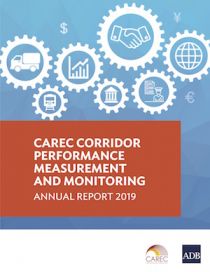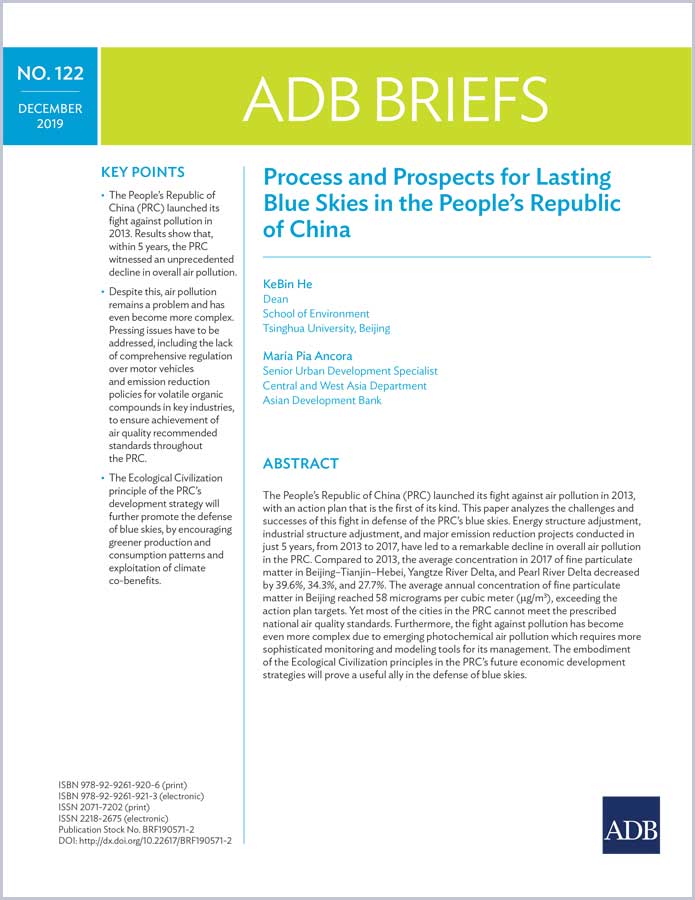CAREC Corridor Performance Measurement and Monitoring: Annual Report 2019







ADB is helping a new tech hub in the PRC respond to user needs as it develops a sustainable public transport system.
Visiting Gui’an, the capital of Guizhou province in the People’s Republic of China (PRC), makes you feel like you’ve stepped into a time-lapse film about structural transformation.
Farming villages are giving way to high rises. Hundreds of tech firms—including giants like Alibaba—have set up shop in recent years, drawing in talent from across the country. Former farmers are retraining to take up jobs in the services sector.
Historically among the poorest provinces in the PRC, Guizhou has the ambition to become the country’s data valley by 2020. The contrast between old and new is starkest in Gui’an New District, which is projected to become the heart of Guizhou’s tech hub. ADB is helping the government develop an intelligent transport system (ITS) and sustainable transport infrastructure to make public transport enticing for all, averting the fate of many cities that are choking in traffic.
Our challenge was to design a transport system that is inclusive of the whole spectrum of users – from tech-savvy digital natives to elderly people with limited mobility and IT literacy.
We used human-centered design to better understand people’s mobility needs. Human-centered design (sometimes also called design thinking) is a tried and tested innovation methodology that grew out of Silicon Valley. It has inspired now ubiquitous products such as the mouse, originally designed for Apple in 1980.
Human-centered design puts an emphasis on understanding user needs – both explicit and latent. Insights from conversations with users become the basis for exploring innovation opportunities. For example, design researchers observed that people tend to round up decimals when writing cheques to make addition easier. This inspired a service that rounds up debit card purchases to the nearest dollar, and then transfers the difference into a savings account.
Promising ideas are brought to life as quick-and-dirty prototypes, which are then tested and refined. Development practitioners will recognize participatory principles in the design thinking toolbox, repackaged into an agile problem-solving process.
To understand user needs, we talked to a variety of people in Gui’an about how and what transport they used, which sparked dozens of ideas for small tweaks that could make public transport more user-friendly for everyone. We will experiment with fold-away seating for toddlers on buses, or an app that helps elderly people navigate the city safely by notifying family members when planned journeys go off-track.
Perhaps most importantly, our conversations revealed that physical mobility is closely bound up with social and economic mobility in people’s minds.
While the breakneck pace of change has unleashed a lot of optimism in Gui’an, there is also concern about the digital divide and the future of work. Digital services provide unparalleled convenience for most people, but risk excluding those with low levels of IT literacy. At the same time there is concern about how automation and artificial intelligence will affect wages and jobs, especially for people with low levels of education.
To help tackle these challenges, the project will run a series of “inclusion hackathons,” events where computer programmers and other experts come together to develop apps and services focused on social inclusion and mobility, drawing on data from the ITS.
The project will also leverage the ITS to organize coding camps for school aged girls during their summer break. We hope this will motivate girls to pursue STEM education and careers, contributing to closing the digital gender gap.
We are eager to see how the project evolves as the collaboration with our partners in Gui’an continues. So far, our experiment with design thinking has left us feeling optimistic about its potential to put people’s needs at the heart of infrastructure development, and to help us work more collaboratively across sectors.
We hope that we can continue to experiment with human-centered design and expand its application to other infrastructure projects in Asia and the Pacific.

Senior Transport Specialist, East Asia Department, ADB

Social Development Specialist, East Asia Regional Department, ADB
This blog is reproduced from Asian Development Blog.


The PRC’s experience in putting low-carbon buses on their city roads can inform other countries interested in the technology.
Air quality is a growing concern for many Asian cities as poor air quality has direct health impacts for residents. Transport contributes to this deteriorating air quality via greenhouse gas (GHG) and particulate matter emanating from exhaust pipes of vehicles.
One way to stem air pollution from transport is to deploy low-carbon emission buses (LCBs), which include hybrid, plug-in hybrid, and battery electric buses (BEB).
The People’s Republic of China (PRC) has one of the world’s largest fleets of electric and plug-in hybrid buses, with around 300,000 plying its urban streets. The PRC’s experience in putting low-carbon buses on the road can provide lessons for other cities as they make decisions about how to use this technology.
We assessed how things were working in 16 cities across the PRC. This is what we learned.
Technology
Hybrid buses have one of two sources of onboard power (diesel-hybrid or gas-hybrid) with a small battery. They are used as an intermediate technology toward full electrification, especially for larger buses and long routes with high passenger demand. In PRC cities, hybrids use around 20% less fuel than fossil fuel buses, with an incremental 20% higher investment cost that is recovered from energy savings during the lifetime of the vehicle.
Plug-in hybrid buses, which can be directly charged at the grid, are very popular in the PRC. Although they cost 20% more than standard hybrids, most drivers do not always charge their buses, so the environmental impact is similar.
Which type of electric bus system is best for PRC cities?
Purchasing plug-in hybrids is therefore not advisable due to their higher cost and limited additional environmental value compared to standard hybrids.
BEBs are fully electric buses that have different charging configurations. They include vehicles charged only overnight, those that are fast-charged during the day, “opportunity charge” BEBs charged at the end of routes or at stops, and electric trolleybuses that operate with overhead wiring.
The chosen system configuration determines the quantity of batteries (and therefore the price), the charging infrastructure, the electricity price (which is dependent on when the bus charged and which power is used to charge the bus), and the operational management of the buses. BEBs are best used on short- to medium-distance routes with buses up to 12 m long, while opportunity charge systems and trolleybuses are ideal for high-demand and long routes with articulated vehicles.
Bus operators need to optimize the electric bus system configuration and charging scheme. They must consider parameters such as route distance, performance in the summer with air conditioning use, battery reserve rates, and battery capacity that declines over time. The optimal configuration will also depend on technical and route criteria and electricity prices.
Picking the most effective and cost-efficient electric bus is a far more complex procedure than choosing between diesel and gas, and most PRC cities have not carried out this process in a stringent manner. This has resulted in buses with sub-optimal battery packs, and more BEBs than are needed.
Environmental impact
Electric buses use four times less energy than fossil fuel-powered units. While BEBs are very sensitive to air conditioning or heating system use on board, which can result in a 50% increase in electricity consumption, overall their GHG emissions are 30%-40% lower than fossil-fuel buses, although their environmental impact depends on how “green” the source of power is. Greening the electric grid is therefore imperative to reap the GHG potential of BEBs.
Clear environmental case for electrifying the PRC bus fleet
Even considering bus and battery manufacturing and disposal, electric buses also have a significantly longer life cycle than conventional buses, and their batteries can be reused in stationary applications.
Electric buses obviously curb local air pollution and noise. However, in absolute terms they have a diminishing advantage in the PRC as stringent emission standards for conventional buses also yield very low emissions of air pollutants including nitrogen oxides and particle matter. Electric buses only make a decisive contribution toward improved air quality in cities with vehicle emission standards of Euro 4 or lower.
Financial impact
Investment costs for LCBs vary between cities, depending on bus specifications. Hybrids cost 20%-25% more than conventional buses, plug-in hybrids 40%-50% more, and BEBs are more than double the price.
The average investment cost for chargers is $150 per kilowatt (kW) of power. Including auxiliary electric equipment such as transformers can raise the figure to around $300–$350/kW. In most cities, the charging infrastructure is financed, owned, and operated by third parties, which levy an average service fee of $0.05–$0.08/kWh.
LCBs have higher investment costs but lower operational costs because they use less energy and, in the case of BEBs, lower maintenance costs. On the other hand, BEBs have a 20% higher tire usage, which accounts for around 40% of the total maintenance cost.
Conventional and hybrid units are within a comparable range of total cost of ownership (TCO) in the PRC. The TCO of BEBs, however, is around 30% higher, and would only be comparable to conventional units if they were operated for 16 instead of 8 years (or 2 battery cycles). Expected future oil price increases and lower battery costs (resulting in lower electric bus costs) will also help close this gap, and make electric buses financially competitive with conventional units.
As PRC moves forward on electric buses, most cities will adopt BEB
The PRC promotes LCBs using financial incentives. Current schemes cover all the incremental costs of LCBs and make purchasing BEBs attractive to investors, although BEBs have a problem with battery disposal.
New interim rules in the PRC make electric vehicle manufacturers responsible for recycling batteries. Together with battery makers, they are required to trace owners of discarded batteries. Battery makers are also encouraged to adopt standardized and easily dismantled product designs to help automate the recycling process, and must teach electric bus manufacturers how to properly store and dismantle old batteries.
As the PRC moves toward full electrification of its urban bus fleet, cities must figure out how to electrify larger buses, choose the appropriate bus and charging technology, use BEBs on longer routes, determine the optimal battery pack, and optimize charging and bus technology to reduce energy costs.
Electric buses reduce GHG emissions, even in the context of a fossil fuel-dominated grid. However, further GHG emission reductions in the PRC will only be possible if electricity production makes a greater shift toward renewables.
As the PRC moves forward on electric urban buses, its technology and policies is likely that BEB will become more popular due to their environment and financial benefits.
Other PRC cities can benefit from the lessons in the 16 cities we studied. And other Asian cities can similarly consider the PRC experience as they consider how to electrify their own urban buses.

Senior Transport Specialist, East Asia Department, ADB

Senior Transport Sector Officer, East Asia Regional Department, ADB
This blog is reproduced from Asian Development Blog.

© 2026 Regional Knowledge Sharing Initiative. The views expressed on this website are those of the authors and presenters and do not necessarily reflect the views and policies of the Asian Development Bank (ADB), its Board of Governors, or the governments they represent. ADB does not guarantee the accuracy of the data in any documents and materials posted on this website and accepts no responsibility for any consequence of their use. By making any designation of or reference to a particular territory or geographic area, or by using the term “country” in any documents posted on this website, ADB does not intend to make any judgments as to the legal or other status of any territory or area.
